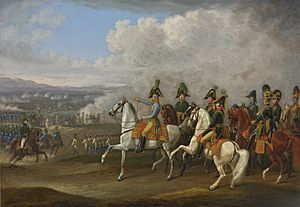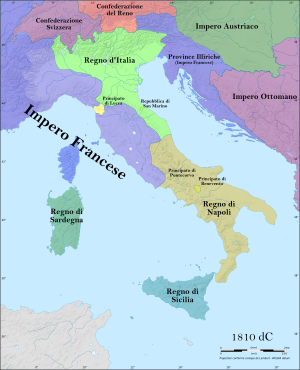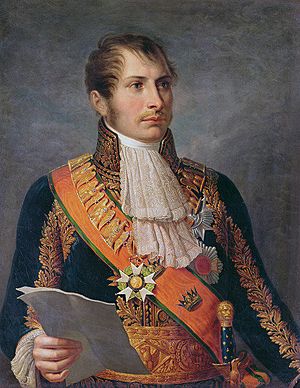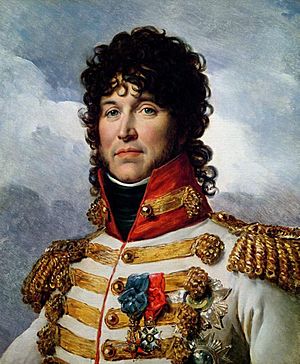Italian Campaign of 1813-1814 facts for kids
Quick facts for kids Italian Campaign of 1813-1814 |
|||||||||
|---|---|---|---|---|---|---|---|---|---|
 General von Bellegarde and his staff in a painting by Albrecht Adam of 1815 |
|||||||||
|
|||||||||
| Belligerents | |||||||||
| Commanders and leaders | |||||||||
| Strength | |||||||||
| 50,000 Austrian soldiers (1813) 30,000 Neapolitan soldiers (since 1814) |
100,000 soldiers in total (summer 1813) 46,000 Franco-Italian soldiers (since 1814) |
||||||||
| Casualties and losses | |||||||||
| Thousands of dead, wounded and captured | Thousands of dead, wounded and captured | ||||||||
The Italian Campaign of 1813-1814 was a series of battles during the War of the Sixth Coalition. These fights mainly happened in northern Italy. They were between the French Empire and a group of countries called the Coalition. This Coalition was led by the Austrians and the British.
This campaign was the last time that French and Austrian armies fought for control of the Italian peninsula. This had been happening since the campaign of 1796-1797.
After a terrible defeat in Russia, the army of the Kingdom of Italy was very weak. Even so, it fought well in the German campaign of 1813. But when the Austrian Empire joined the war on August 12, 1813, most of the Italian army was called back. They needed to defend Italy from the Coalition invasion.
The French and Italian army was led by Eugène de Beauharnais. He was the viceroy of Italy and Napoleon Bonaparte's stepson. The Coalition army was commanded by Austrian general Heinrich Johann Bellegarde and British general William Bentinck. Other allies included the Kingdom of Sicily and the Kingdom of Sardinia.
At first, the French and Italians slowed down the Coalition's advance. This happened in the Illyrian Provinces, especially at the Battle of Feistritz. But by October 5, they had to retreat to the Isonzo river. This river was the eastern border of the Kingdom of Italy. The invasion of the kingdom began in mid-October.
The French and Italian forces were already outnumbered. Things got worse when the Kingdom of Bavaria and then the Kingdom of Naples switched sides. Joachim Murat, the King of Naples, changed sides to keep his power. He also hoped to unite much of Italy under his rule.
Even with these challenges, Beauharnais's troops fought bravely in the Po Valley. They won battles against the Austrians at Caldiero and Mincio. However, spring 1814 brought more defeats. The Coalition continued to advance into Italy.
Meanwhile, Napoleon was defeated in France and gave up his titles in April. This meant his power in Italy ended. On April 23, Eugène de Beauharnais signed the Convention of Mantua. He then went to live in Bavaria. By the end of April, the remaining Italian forces had to surrender.
The fall of the Kingdom of Italy was a sad event for Italian patriots. Writers like Ugo Foscolo and Alessandro Manzoni saw their dream of a united Italy disappear. Manzoni wrote a song about it, wishing for Italy to stay independent. The memory of a free Italian state under Napoleon later inspired patriots. They continued to fight for Italian unification during the Risorgimento.
Historical Background
After the Battle of Lützen, Napoleon, who was also King of Italy, sent his stepson Eugène de Beauharnais to Italy. His job was to gather the kingdom's forces against the Coalition. Most of the regular soldiers of the Kingdom of Italy had died in Russia. So, Beauharnais had to rebuild the army.
He used the fact that the Austrian Empire was neutral for a short time. By July 1813, he had gathered 45,000 foot soldiers, 1,500 cavalry, and 130 cannons. When Austria joined the war in August 1813, its former lands in Croatia began to rebel against French rule. Napoleon had taken these lands and added them to his empire.
Campaign in the Illyrian Provinces
Beauharnais placed his soldiers along the road from Tarvisio to Ljubljana to face the Austrians. These Austrians were led by General Johann von Hiller. In late August and early September, Beauharnais ordered an attack near Villach. These attacks were successful for a short time.
However, the city of Fiume was taken by Field Marshal Laval Nugent von Westmeath. All of Istria also fell to the Austrians. Beauharnais sent General Domenico Pino to fight Nugent. Pino won battles at Jeltschaneand and Lipa. On September 15, his troops took Rijeka.
But Beauharnais was not happy. He replaced Pino with General Giuseppe Federico Palombini. Palombini could not stop the Austrians from taking back Fiume, Lipa, and Adelsberg. They also began to block Trieste.
At this point, Dalmatia was lost to the French Empire. Many Croatian soldiers left the army. Uprisings by the local people became too much to handle. By the end of 1813 and early 1814, many towns and forts in Dalmatia surrendered. The last to fall were Cattaro and Ragusa in January 1814.
Fighting in Italy
In October 1813, Beauharnais pulled his troops back to the Isonzo river. On October 15, the Austrian army, with 50,000 men, entered the Kingdom of Italy. They came from the east and north. They invaded South Tyrol and reached Trento.
The fighting mostly involved clever troop movements. Beauharnais's troops were pushed out of their positions. By November 1813, they stopped along the Adige river. In the same month, the King of Bavaria, Maximilian I Joseph of Bavaria, asked his son-in-law Eugène to give up fighting for Napoleon. But Beauharnais refused.
On October 29, the castle of San Giusto di Trieste surrendered to Nugent. Nugent then landed near Goro, Emilia–Romagna on November 15. In four days, he captured several towns, including Ferrara and Rovigo. He then joined forces with Hiller, who was blocking Venice. However, General Hiller was defeated at Caldiero on November 15.
French generals tried to take back the Polesine region but failed. They could not stop Nugent from advancing. General Pino did manage to take back Ferrara on November 26. At the same time, British and Sicilian troops landed on the coast of Tuscany. They hoped to encourage the local people to rebel. They briefly occupied Lucca but then left.
From the Adige river line, Beauharnais watched the situation. He was more worried about Joachim Murat, the King of Naples, than the Austrians. After Napoleon's defeat at the Battle of Leipzig, Murat had left Napoleon's main army. Murat met Beauharnais and suggested they divide Italy between them. He wanted to make Italy independent from France and defend it together.
Murat had long wanted to unite Italy under his rule. Now that Napoleon was losing, he wanted to break free from him. He sought help from the Coalition and used the idea of Italian independence. Murat returned to Naples on November 4. To please the British, he ended Napoleon's trade rules. He also began talking with Austria and General Lord William Bentinck.
Murat sent two divisions of his army to Rome and Ancona. He told Napoleon these troops were for defending northern Italy. But he told Austria they were not hostile. In early December, Murat's Neapolitan army occupied Rome and Ancona. The French and Italian forces were unsure of his true intentions.
Finally, on January 11, 1814, Murat signed an alliance with Austria in Naples. This agreement allowed him to keep his kingdom. It also secretly promised him more land in the Papal States. In return, Murat gave up his claims on Sicily. He also promised to support the Coalition with 30,000 soldiers. On January 21, 1814, the Kingdom of Naples officially switched sides.
However, Murat avoided directly fighting the French and Italian troops. This allowed Beauharnais's forces to slow down the Austrian and British advance. Under pressure from his new allies, Murat made slow attacks with little success.
With the war clearly going in favor of the Coalition, Napoleon wrote to Eugène. He told his stepson to leave Italy and retreat to the Western Alps. But Beauharnais refused. He wanted to fight the Austro-Neapolitan army. Napoleon also freed Pope Pius VII to prevent the Coalition from doing so.
Meanwhile, Field Marshal Heinrich Johann Bellegarde took command of the Austrian army on December 15, 1813. In January, he ordered a new attack along the Adige river. While Nugent occupied all of Romagna, Bellegarde convinced Murat to send 20,000 of his men to fight Beauharnais.
On February 8, Beauharnais decided to attack the enemy. But on that same day, Bellegarde also ordered his troops to cross the Mincio river. This led to a very bloody battle. Beauharnais initially held his ground against the Austrians, but his position eventually became lost.
On February 11, Murat occupied the citadel of Ancona, which the French had left. In early March, the Austrians faced Beauharnais near Parma. On March 6, Nugent decided to attack the enemy in Reggio Emilia. On March 7, Austrian and Neapolitan troops marched to Reggio.
By March 10, the Austrians had reached the Taro river and were nearing Piacenza. After hearing that Napoleon had given up his throne, Eugène signed an agreement on April 16. He gave up his weapons and handed over command of the Kingdom of Italy's troops to Bellegarde. Eugène wanted to be crowned king, but the Italian Senate refused.
Venice was taken by the Austrians on April 20. The city of Genoa was also captured by the British and Sicilians on the same day. Also on April 20, a rebellion broke out in Milan. This led to the death of the Minister of Finance, Giuseppe Prina.
Because of these events, Beauharnais signed the Convention of Mantua on April 23. This agreement allowed the Austrians to take control of all of northern Italy. Beauharnais then went to live in Bavaria.
The Austrians entered Milan on April 28. King Vittorio Emanuele I of Savoy entered Turin on May 20. On April 27, the French forces in Piacenza surrendered. The fortress of Mantua surrendered on April 28.
Related items
- Fall of the Kingdom of Italy
- Battle of Feistritz
- Battle of Caldiero (1813)
- Battle of the Mincio River (1814)
- Siege of Genoa (1814)
- it:Cattura di La Spezia
- it:Assedio di Trieste




